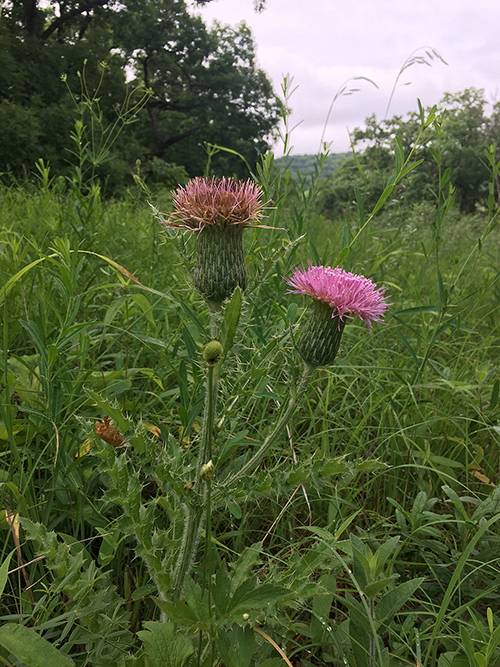
MIKE MILLER
Hill’s Thistle is native to the Great Lakes Region, including Illinois. In our state, there are 39 documented and tracked occurrences of the plant. Only 17 populations of Hill’s Thistle in Illinois are found within the protected confines of Illinois Nature Preserves, or are growing in areas that are being managed for their protection. In Illinois it is considered a species that is Critically Imperiled by NatureServe.

Hill’s Thistle in bloom at Camp Wokanda, Peoria Park District. (PHOTO BY MIKE MILLER)
Unlike some of its more aggressive cousins, Hill’s Thistle is a diminutive plant, rarely growing 2 feet tall. It is also has less prickly, light-green leaves that are more oval shaped with a silvery hue to the under-surface. It is considered a short-lived perennial, spending most of its life as a set of basal leaves. When conditions are right, the plant will bloom, sending up a short flowering stalk topped with a pink flower-head comprised of hundreds of tiny blooms clustered together in a classic “thistle” flower. Presumably, after the plant blooms, it dies off. Unlike other thistles that produce large amounts of viable seed, the Hill’s Thistle has very low numbers of seeds that grow into new plants. This could be due to the fact that the plant is so rare, that it receives insufficient pollination in the wild, but botanists have also had very little success in increasing seed germination in greenhouse settings.
One theory is that Hill’s Thistle had a unique niche in our Great Lakes region prairie habitats… Buffalo wallows. Bison were a major influence on the landscape. Their migratory activity created trails and traces that disturbed large stretches of prairie. This would have created areas where plant competition was low, allowing the diminutive thistle a place to take root. We know that Hill’s Thistle has a hard time growing where it can be outcompeted by long-lived perennials or areas where the prairie sod is thick and crowded. In fact, in today’s landscape, we often find Hill’s Thistle growing in areas where the soil is so poor, and the prairie vegetation is not overly thick.
One population of Hill’s Thistle is found at Camp Wokanda, where it grows on a dry, glacial drift hill prairie. For years, I have observed the basal leaves of several Hill’s Thistle growing amongst the sparse prairie plants on the dry, gravelly slope. In my 35+ years observing this prairie, I have never seen it bloom. Until last year, when in June, a lone plant set up a flower stalk with two flower heads. Seeds were collected. Some were redistributed throughout Wokanda’s hill prairie. Some were distributed to another suitably similar habitat. Some were grown in a controlled environment. Those we tried to grow under control had a very low germination rate (less than 15%), so it is makes me wonder just how this species managed to survive for as long as it has.
Perhaps the answer to its survivability has something to do with an ancient partner of the prairie. The Bison and the Hill’s Thistle have something in common. Both, today, are relegated to habitats that are marginal for their long-term well-being. When we think of Bison today, what place comes to mind? The mountainous valleys of Yellowstone are what we think of as the bison’s realm. We don’t think of the Midwest’s river valleys of the Illinois or Mississippi as being home to the bison, but historically this is where they are from. The bison of Yellowstone were the bison that escaped the slaughter of the Midwest and were relegated to a tough life, eking out an existence in a home they were not designed to thrive within. Much like the bison are surviving in the mountains, our remaining Hill’s Thistle are just holding on in a few dry hill prairies and remnants that happen to be so inhospitable that few things can grow and out-compete them. For both of these species (bison and thistle), their ideal homeland is gone, yet they persist.
As with most things in nature, there are no truly independent organisms. We call it the web of life for a reason. Each strand is connected to another. Some directly, some by complex associations. Undoubtedly, the Hill’s Thistle and the bison shared a close kinship in both the web of life, and upon the landscape. Someday, we might be able to reintroduce these old companions and strengthen the strands between prairie plants and animals.

2 comments for “Nature Rambles | The Kinship of Thistle and Bison”
Recent Comments
Beautiful essay, another reason why we need to bring the bison back — and Hill’s Thistle! Restoring some of our wetlands would probably help: https://www.wetlands-initiative.org/how-the-midwest-lost-its-wetlands
Thanks for the kind words Bill. The Wetlands Initiative (TWI) is a great organization and doing fabulous work in protecting and restoring native Illinois habitats. Wetland restoration is crucial to preserving the mosaic of habitats that make up ancient Illinois. TWI has also restored several acres of upland prairie habitat in their Sandy Hollow addition to the Dickson Waterfowl Refuge.